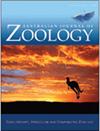Intraspecific hybridisation of an invasive lizard on Lord Howe Island
IF 1
4区 生物学
Q3 ZOOLOGY
引用次数: 0
Abstract
ABSTRACT Human-mediated dispersal of animals often acts to bring populations that have been separated for substantial periods of evolutionary time (e.g. millions of years) in their native range into contact in their introduced range. Whether these taxa successfully interbreed in the introduced range provides information on the strength of reproductive isolation amongst them. The invasive delicate skink (Lampropholis delicata) has been accidentally introduced to Lord Howe Island from four genetically divergent (>2 million years) regions of the species’ native range in eastern Australia. We used mitochondrial DNA and microsatellite data to investigate whether the individuals from four of the native-range source regions are interbreeding on Lord Howe Island. Our analyses indicate that intraspecific hybridisation among individuals from all four native-range source regions is occurring. Although there is little evidence for hybrids in the northern end of Lord Howe Island (proportion of hybrids: 0–0.02; n = 31), there is a high proportion of hybrids in the central (0.33–0.69; n = 59) and southern regions (0.38–0.75; n = 8) of the island. Given the strong evidence for interbreeding among all four native-range source regions examined, and the relatively minor morphological, life-history and phenotypic variation among them, we suggest that the delicate skink should continue to be treated as a single, widespread, but variable species.豪勋爵岛上一种入侵蜥蜴的种内杂交
人类介导的动物传播通常会使在原生范围内分离了相当长一段进化时间(例如数百万年)的种群在引入范围内接触。这些类群在引进范围内是否成功杂交提供了它们之间生殖隔离强度的信息。入侵的精致石龙子(lamproolis delicata)意外地从澳大利亚东部的四个基因不同的地区(> 200万年)引入了豪勋爵岛。我们使用线粒体DNA和微卫星数据来调查来自四个本地来源地区的个体是否在豪勋爵岛上进行杂交。我们的分析表明,来自所有四个本地来源地区的个体之间正在发生种内杂交。尽管在豪勋爵岛北端几乎没有杂种的证据(杂种比例:0-0.02;N = 31),中部杂交种比例较高(0.33 ~ 0.69;N = 59)和南部地区(0.38-0.75;N = 8)。鉴于所有四个本地源区域之间存在杂交的有力证据,以及它们之间相对较小的形态、生活史和表型差异,我们建议将精致的石龙子继续视为一个单一的、广泛分布的、但可变的物种。
本文章由计算机程序翻译,如有差异,请以英文原文为准。
求助全文
约1分钟内获得全文
求助全文
来源期刊
CiteScore
2.40
自引率
0.00%
发文量
12
审稿时长
>12 weeks
期刊介绍:
Australian Journal of Zoology is an international journal publishing contributions on evolutionary, molecular and comparative zoology. The journal focuses on Australasian fauna but also includes high-quality research from any region that has broader practical or theoretical relevance or that demonstrates a conceptual advance to any aspect of zoology. Subject areas include, but are not limited to: anatomy, physiology, molecular biology, genetics, reproductive biology, developmental biology, parasitology, morphology, behaviour, ecology, zoogeography, systematics and evolution.
Australian Journal of Zoology is a valuable resource for professional zoologists, research scientists, resource managers, environmental consultants, students and amateurs interested in any aspect of the scientific study of animals.
Australian Journal of Zoology is published with the endorsement of the Commonwealth Scientific and Industrial Research Organisation (CSIRO) and the Australian Academy of Science.

 求助内容:
求助内容: 应助结果提醒方式:
应助结果提醒方式:


